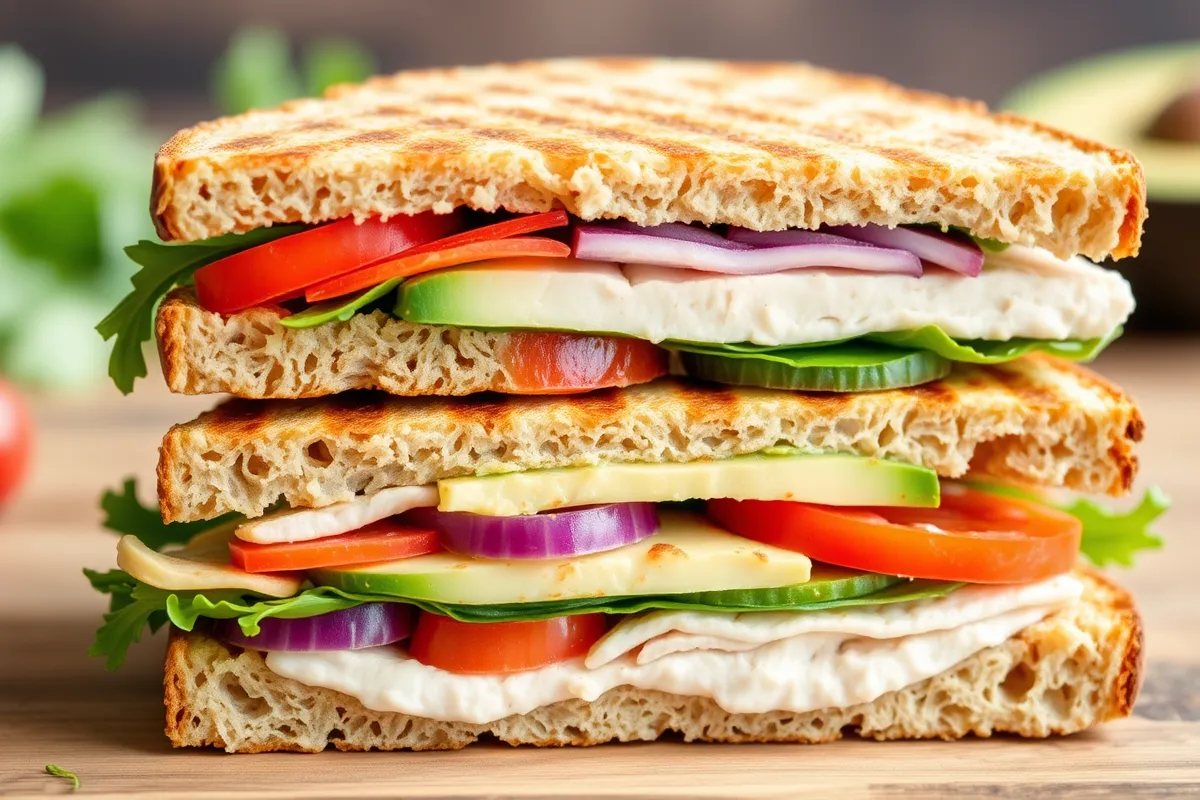Table of Contents
Are panini breads healthy? It’s a common question for anyone trying to eat well without giving up satisfying sandwiches. This article explores their nutritional value, health benefits, and how to make smart choices when enjoying panini breads. This article explores whether panini breads are a healthy option, considering nutritional content, preparation methods, and alternatives to make your meals both tasty and nutritious.
Understanding Panini Breads
What Are Panini Breads?
Panini breads are typically made from ciabatta, baguette, or focaccia dough, known for their crispy crusts and soft interiors. They are designed to hold fillings well and are usually pressed and grilled to create a warm, toasty sandwich.
Types of Panini Breads
There are several types of bread used to make paninis, each with its unique characteristics:
- Ciabatta: An Italian bread with a slightly crispy crust and a soft, porous interior. It’s perfect for absorbing flavors from fillings without becoming soggy.
- Baguette: A long, thin loaf with a crunchy crust and a chewy center. Baguettes offer a substantial base for hearty fillings.
- Focaccia: A flat oven-baked bread topped with olive oil, herbs, and sometimes vegetables. Focaccia adds a flavorful twist to paninis.
- Whole Grain Varieties: These include breads made with whole wheat, rye, or other whole grains, providing added fiber and nutrients.
Each type of bread can affect the overall nutritional profile of the panini, making it important to choose the right one based on your dietary needs.
Nutritional Profile of Panini Breads
Panini breads vary in their nutritional content based on the type of bread used. Generally, they contain:
- Carbohydrates: A primary energy source, providing about 40-50 grams per serving.
- Protein: Approximately 8-10 grams, aiding in muscle repair and growth.
- Fats: Around 2-5 grams, depending on the recipe.
- Fiber: Typically 2-4 grams, contributing to digestive health.
- Vitamins and Minerals: Including B vitamins, iron, and magnesium.
Additionally, whole grain panini breads offer higher fiber content and more vitamins compared to those made with refined flour.
Are Panini Breads Healthy?

Are panini breads healthy? The answer depends on various factors such as ingredients, portion sizes, and preparation methods. When made with whole grains and minimal additives, panini breads can be a nutritious choice. However, some commercial varieties may contain higher levels of sodium and preservatives, which can impact their healthiness.
Health Benefits of Panini Breads
Whole Grain Panini Breads
Opting for whole grain panini breads enhances their nutritional value. Whole grains provide:
- Higher Fiber Content: Aiding in digestion and promoting satiety.
- Essential Nutrients: Including vitamins and minerals necessary for overall health.
- Lower Glycemic Index: Helping to maintain stable blood sugar levels.
Balanced Macronutrients
Panini breads offer a balanced mix of carbohydrates, proteins, and fats, making them a suitable base for a nutritious meal. Combining them with lean proteins and plenty of vegetables can create a well-rounded sandwich.
Versatility and Customization
One of the advantages of panini breads is their versatility. You can customize your sandwich with a variety of healthy fillings such as:
- Lean Proteins: Turkey, chicken, tofu, or legumes.
- Fresh Vegetables: Spinach, tomatoes, bell peppers, and cucumbers.
- Healthy Fats: Avocado or a small amount of olive oil.
This flexibility allows you to tailor your panini to meet your specific dietary needs and preferences.
Enhanced Flavor and Satisfaction
Grilling panini breads not only improves their texture but also enhances their flavor. The toasting process can bring out the natural sweetness of the bread and caramelize the fillings, making the sandwich more satisfying and enjoyable.
Potential for Nutrient-Rich Fillings
Panini sandwiches can be packed with nutrient-dense ingredients. By choosing fillings rich in vitamins, minerals, and antioxidants, you can boost the nutritional profile of your meal significantly.
Potential Downsides of Panini Breads
High Sodium Content
Some panini breads may contain elevated levels of sodium, which can contribute to high blood pressure and other cardiovascular issues. It’s important to check the nutritional labels and choose low-sodium options when possible.
Refined Flour Usage
Panini breads made with refined flour lack the fiber and nutrients found in whole grains. Consuming too much refined flour can lead to spikes in blood sugar levels and may contribute to weight gain over time.
Added Sugars and Preservatives
Commercially prepared panini breads might include added sugars and preservatives to enhance flavor and shelf life. These additives can negate some of the health benefits, making it essential to read ingredient lists carefully.
Caloric Density
Depending on the type of bread and fillings used, panini sandwiches can be relatively high in calories. It’s important to be mindful of portion sizes and ingredient choices to keep the calorie count in check.
Making Healthier Panini Breads
Choosing the Right Bread
Selecting a whole grain or whole wheat panini bread is a simple way to improve the healthiness of your sandwich. These options provide more fiber and nutrients compared to their refined counterparts.
Homemade Panini Breads
Making panini breads at home allows you to control the ingredients and avoid unwanted additives. You can experiment with different grains, seeds, and natural sweeteners to create a healthier version.
Gluten-Free Panini Options
For those with gluten sensitivities or celiac disease, gluten-free panini breads made from alternative flours like almond, rice, or chickpea flour can be a great option. These alternatives often offer different nutritional benefits and cater to specific dietary needs.
Smart Fillings and Toppings
To maximize the nutritional benefits of your panini, focus on:
- Lean Proteins: Grilled chicken, turkey breast, or plant-based proteins.
- Vegetables: Load up on fresh or lightly sautéed vegetables.
- Healthy Fats: Use avocado, hummus, or a drizzle of olive oil instead of creamy dressings.
Grilling Techniques
Using a panini press with minimal added fats can help keep your sandwich lower in calories. Alternatively, you can grill your panini on a non-stick skillet to achieve a crispy texture without excess oil.
Portion Control
Being mindful of portion sizes is crucial. Stick to one panini bread per meal and pair it with a side of vegetables or a salad to ensure a balanced diet.
Incorporating Superfoods
Adding superfoods like spinach, kale, or quinoa to your panini can boost its nutritional value. These ingredients are rich in antioxidants, vitamins, and minerals that support overall health.
Comparing Panini Breads to Other Bread Options
Panini vs. Wraps
Is a wrap or panini healthier? Wraps often contain fewer calories and can be made with whole grain or low-carb tortillas, making them a lighter option. However, panini breads can offer more substantial fiber and protein when paired with nutritious fillings.
Panini vs. Sandwich Breads
Compared to regular sandwich breads, panini breads are usually heartier and can hold more fillings without becoming soggy. This allows for a more diverse and balanced combination of ingredients.
Panini vs. Bagels
Bagels are typically higher in calories and carbohydrates, whereas panini breads offer a more balanced macronutrient profile, especially when choosing whole grain varieties.
Panini vs. Sourdough
Sourdough bread, known for its tangy flavor and chewy texture, is another popular choice. It often contains probiotics from the fermentation process, which can aid in digestion. While both sourdough and panini breads have their benefits, panini breads may offer more versatility in sandwich preparation.
Incorporating Panini Breads into a Healthy Diet
Portion Control
Being mindful of portion sizes is crucial. Stick to one panini bread per meal and pair it with a side of vegetables or a salad to ensure a balanced diet.
Balanced Meals
Ensure that your panini sandwich includes a good mix of proteins, healthy fats, and vegetables. This balance helps in maintaining energy levels and overall health.
Moderation and Variety
While panini breads can be part of a healthy diet, it’s important to consume a variety of bread types and other carbohydrate sources to ensure a wide range of nutrients.
Frequency of Consumption
Including panini sandwiches in your diet a few times a week can be part of a balanced eating plan. However, it’s important to vary your meals and not rely solely on panini breads for your carbohydrate intake.
Pairing with Healthy Sides
Complement your panini with nutrient-rich sides such as a mixed green salad, fresh fruit, or a bowl of vegetable soup. This enhances the overall nutritional profile of your meal.
Advanced Tips for Healthier Panini Preparation
Using Herbs and Spices
Incorporating herbs and spices like basil, oregano, or black pepper can add flavor without the need for excess salt or unhealthy sauces.
Opting for Low-Fat Cheese
Choosing low-fat or part-skim cheeses can reduce the overall fat content of your panini while still providing the creamy texture and flavor you desire.
Incorporating Plant-Based Proteins
For a vegetarian or vegan option, use plant-based proteins such as grilled tofu, tempeh, or legumes. These alternatives are rich in protein and fiber, making your panini both filling and nutritious.
Avoiding Processed Meats
Instead of processed meats like salami or ham, opt for lean cuts of meat such as grilled chicken breast or turkey. Processed meats often contain high levels of sodium and preservatives, which can be detrimental to health.
Adding Whole Food Condiments
Use whole food-based condiments like mustard, pesto, or hummus instead of creamy dressings. These options add flavor and nutrients without unnecessary sugars and unhealthy fats.
Market Trends and Healthier Panini Options
Increasing Demand for Whole Grain Products
Consumers are becoming more health-conscious, leading to an increased demand for whole grain and nutrient-rich bread options. This trend has prompted many bakeries and brands to expand their offerings to include healthier panini bread varieties.
Rise of Artisanal and Organic Breads
Artisanal and organic panini breads are gaining popularity due to their perceived health benefits and superior taste. These breads are often made with fewer preservatives and higher-quality ingredients, appealing to health-minded consumers.
Gluten-Free and Specialty Diets
The growing awareness of gluten intolerance and celiac disease has led to a surge in gluten-free panini bread options. Additionally, specialty diets like keto and paleo have inspired the creation of low-carb and grain-free panini breads, catering to diverse dietary needs.
Sustainable and Ethical Production
Consumers are increasingly concerned about the sustainability and ethical practices behind their food. Many panini bread manufacturers are adopting sustainable practices, such as using organic ingredients and eco-friendly packaging, to attract environmentally conscious customers.

Conclusion
So, are panini breads healthy? The answer lies in how you choose and prepare them. When made with whole grain options and nutrient-rich fillings, panini breads can be part of a balanced, satisfying, and even health-promoting diet. By paying attention to portion sizes, limiting processed ingredients, and pairing your panini with wholesome sides, you can enjoy this beloved sandwich style without compromising your wellness goals.
Frequently Asked Questions
Are paninis healthy for you?
Paninis can be healthy when made with whole grain breads, lean proteins, and plenty of vegetables. Choosing fresh, nutritious fillings and avoiding excess fats and sodium enhances their health benefits.
What is the healthiest bread you can eat?
Whole grain or whole wheat breads are among the healthiest options. They are rich in fiber, vitamins, and minerals, and have a lower glycemic index compared to refined breads.
What is the healthiest type of sandwich?
A sandwich made with whole grain bread, lean proteins like turkey or chicken, plenty of fresh vegetables, and healthy fats such as avocado is considered one of the healthiest types of sandwiches.
Is a wrap or panini healthier?
Both wraps and paninis can be healthy choices, depending on their ingredients. Wraps may be lower in calories, while paninis can offer more fiber and protein when made with whole grain breads and nutritious fillings.

